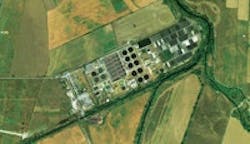About the author: Pavel Mirchev is external sales engineer for Grundfos Bulgaria. Mirchev can be reached at [email protected].
The Sofia Wastewater Treatment Plant (WWTP) at Kubratovo—the largest wastewater treatment plant in the Balkans—treats the domestic wastewater, process water and rainwater from Sofia, the capital of Bulgaria. Pumping 480,000 cu meters of wastewater from a population equivalent of 1,313,000, the Kubratovo WWTP meets the wastewater requirements of 90% of the city’s population.
Spread across 600 acres, the Kubratovo WWTP began operations in 1984. Two refurbishments followed in 1990 and 2001, and on March 30, 2009, a massive refurbishment and expansion project for the plant commenced.
Grundfos was a primary contractor and contributed equipment, technology, and project and logistics know-how; the project was brought in on time and as planned 20 months later, at the end of 2010.
The main goal of the project was to accommodate the additional outlet of wastewater from 342,500 citizens to the Kubratovo WWTP, which, up to that point had been directly discharged into receiving waters. Furthermore, the entry of Bulgaria into the European Union (EU) made expansion of the Kubratovo WWTP necessary. Bulgaria is obliged to comply with the EU’s urban wastewater directive and national regulations for emission norms for the allowable content of harmful and hazardous substances in wastewater discharged into receiving waters in sensitive areas.
Reconstructing & Modernizing Two Sites
The two main aspects of the project involved the reconstruction and modernization of the Sofia WWTP at Kubratovo and the construction of a sewerage pumping station (SPS) and a pressure collector in Novi Iskar district. The project was carried out by the Kubratovo Consortium, which included contractors, system design consultants and suppliers.
A project of this scale had not previously been undertaken in Bulgaria. Therefore, the contractor needed a partner that offered the technological and logistical support necessary, and knowledge about the processes. As the main equipment provider, Grundfos ensured compliance with deadlines, quality of the equipment and installations at handover, and warranty support.
The project was carried out on schedule, without delays resulting from delivery problems. The required working parameters for the Kubratovo installation were reached three months after its commissioning; the time was needed to adjust the system and its operation.
During the execution of the project, it was important that the reconstruction and expansion of the treatment plant was carried out without halting the purification processes for wastewater entering the plant. This required the consortium to work with extreme flexibility, as purification standards had to be maintained at all times, meaning, for example, that the receiving water source—the Iskar River—was not to be polluted.
The second group of activities covered the reconstruction of the Novi Iskar SPS and the refurbishment of the sewer collectors in the region. After the completion of the planned construction work, the capacity was increased to a maximum rainwater flow of 850 liters per second. Additionally, 5 km of sewer collectors in the town of Novi Iskar were refurbished and a rising main was built using fiberglass pipes with nominal diameter of 600 mm and a total length of 5.6 km.
Kubratovo WWTP
For the modernization of the Kubratovo WWTP, four primary sedimentation tanks, six biotanks, six secondary sedimentation tanks, and mud and floating substances pits were refurbished and reconstructed. Additionally, two new secondary sedimentation tanks, a pumping station for recirculation of active sludge, a mud water tank, a reagent plant and a power substation were built. Additional underground infrastructure more than 4 km in length was also created, including pipeline for process water ranging from nominal diameters of 300 to 1,800 mm.
The reagent plant with metering pumps for ferric chloride dosing was built for the removal of phosphorous. The installation consists of a building in which three tanks for ferric chloride are placed, each with a capacity of 70 cu meters. The ferric chloride is dosed using three operating and one standby Grundfos dosing pumps. In total, five dosing pumps for ferric chloride were delivered for the reagent plant, each with a capacity of 375 liters per hour.
The treatment plant was equipped with control and measurement instruments, and a SCADA system was built for control of the technological processes. This ensures automatic operation of the station, with the technological processes controlled and managed by the automated system.
Novi Iskar SPS
The renovation project for the Novi Iskar SPS included reconstructing the collectors through washing, cleaning and repair, cleaning the pumping station and completing the building, cultivating the terrain and restoring the pipeline to Kubratovo.
The renovated pumping station now has entirely new equipment, while keeping the original construction. It has five big pumps; three for domestic wastewater (two operating and one standby) and two for surface water (one operating and one standby) were mounted. The pumping station also has two mixers in the draw tanks, which periodically stir the water to prevent the formation of crust and sludge.
A small drainage pump also was mounted; it is used to pump water from leaks out of the dry chamber where the pumps are installed, preventing flooding. All equipment for the Novi Iskar SPS, which included pumps for domestic wastewater and surface water, was provided by Grundfos Bulgaria.
Download: Here
